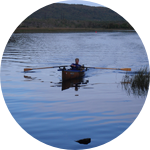About This Project
Wheels advance their contact point in unison with their rolling surface. Cycling a track around turnarounds extends the friction-free point. Add flotation and watercraft friction can be reduced indefinitely.
But wave and turbulent resistance are bigger factors than friction. The reel boat addresses those factors by slowing relative motion at the hydrodynamic interface.
Can the wheel work its magic on the other 2/3 of the earth? Let's find out!
Ask the Scientists
Join The DiscussionWhat is the context of this research?
Rowing a couple of million strokes gives you lots of reasons to contemplate watercraft efficiency, and the gist of the reel boat is simple--the kind of thing that you can see in an instant, if your mind is primed (see the project video to get primed): As a point on a wheel progresses toward its no-relative-motion contact with its rolling surface, it decelerates.
Thus, if a slow-relative-motion point can be extended, the biggest barrier preventing the wheel from improving watercraft efficiency can be removed (this biggest barrier is an inefficient churning of the water).
That's what the reel boat will do: advance toward no-motion contact with the water via slow-motion contact to virtually eliminate hydrodynamic resistance.
Strong initial rationale. But reality is complex. Time to test.
What is the significance of this project?
More than 90% of world trade is shipped via, well, ships. Waterways the world over are favored for recreation. 2/3 of the earth is covered by water. If the wheel's extraordinary efficiency can be applied to watercraft, it could literally and figuratively revolutionize water transportation.
Furthermore, efficiency is not the only environmental benefit of slowing the hydrodynamic interface. Less wave making results, which will protect shores and river banks. And the slow-motion water/watercraft interface will protect marine life.
You can help investigate a potential aid to commerce on a global scale that would actually benefit the environment. A worthy experiment, right?
So join the fun and support the revolution!
What are the goals of the project?
The first reel boat will have tandem cycling hulls that will be divided into 1' sections and attached to a bike chain outfitted with L-brackets. Four bike wheels, suitably adapted, will serve as turnarounds and spacers on each side.
The prototype will be rowed, which means I don't have to buy a motor. I'm squeezing pennies. Also, the baseline for measuring the reel boat's efficiency will be my 6-mile race time in a Kevlar surf ski in 2011, and I rowed the surf ski. (Extraordinarily efficient, a surf ski's been used to set the human-powered 24 hour distance record for watercraft.) See a race picture here.
Budget
I'm doing important research, and Experiment.com is playing an important role in making that research available to people like you!
I value the opportunity to post on this site, because there's no value to an experiment that no one knows about.
It's that simple.
Lab notes are open access--available to all.
Contributors may request a copy of the patent search.
Meet the Team
Team Bio
My story shows that science can be simple and revolutionary.
It begins with bad knees, a love of running, and knowledge that inactivity is as unhealthy as smoking. So I made a rower that facilitates the power output of running with 1/3 the joint stress of walking. But a great way to produce human power motivates a desire to use it well. And with watercraft a challenge to the efficient use of power literally arises when a boat's bow and stern waves intersect and propulsion turns into wave production. With enough power, a boat can plane, and so overcome the so-called "hull speed" limit. That's why my story of facing nature's challenges with just human power is important. It put my focus on a problem that 150 years of the internal combustion engine has obscured.
So rowing 1/3 of a million strokes a year for six years is the biographical fact behind my hypothesis, and the success of the internal combustion engine explains the relevance of that biographical fact.
Additional Information
This elegant boat--against which the reel boat will be compared--not only floats like a feather, it's extraordinarily strong for its weight. To be meaningful, the reel boat experiment must use the best available benchmark.
The very skinny hull sections in the reel boat sketch are explained by using this model of surf ski as the benchmark for the experiment.

Project Backers
- 4Backers
- 25%Funded
- $158Total Donations
- $39.50Average Donation
